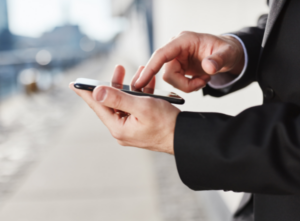Looking for news viewers? Here’s where you’ll find them.

Think about this: almost half of the online purchases on Black Friday were made using a smartphone, not a desktop computer.
Adobe Analytics, which tracks data from most of the top internet retailers in the U.S., says mobile purchases represented 48% of all digital sales on one of the biggest shopping days of the year. Retailers know that if they want to capture consumers, their mobile apps must be easy to navigate, reliable, and updated frequently.
The same is true for local television stations.
Think about this: almost half of local news viewers prefer getting weather updates on a mobile app, not television. Research conducted for The Weather Company, an IBM Business, revealed that 51% of adults said they prefer to use a mobile app if they only have access to one source for daily weather information.
Catching consumers where they are
Ratings for local television news have been declining for decades, beginning about the time I started my career as an on-air broadcast meteorologist. But I don’t take it personally.
Initially, cable TV stole a chunk of news viewers by offering hundreds of channels. Instead of watching local TV, people suddenly had access to WKRP in Cincinnati. (Look it up, kids.) Satellite TV pulled away a few more news viewers with all those movie channels and live sports. Then came the internet, allowing anyone to watch anything, anytime, anywhere.
 Laptops, tablets, and smartphones were initially considered the “second screen,” meaning people used one of these while watching TV. However, today mobile apps are the primary way many people prefer shopping, connecting, consuming entertainment, and finding information.
Laptops, tablets, and smartphones were initially considered the “second screen,” meaning people used one of these while watching TV. However, today mobile apps are the primary way many people prefer shopping, connecting, consuming entertainment, and finding information.
As a result, businesses are rushing to create a good mobile app experience. Almost every grocery store in my neighborhood lets shoppers clip coupons using an app. My doctor uses an app for quick medical questions and prescription refills. My car dealer sends me notifications on their app when it’s time to change the oil and rotate the tires on my car.
The shift in consumer preference should also be a wake-up call for local news stations. Are we providing a meaningful app experience or just repurposing the content we show on TV? Is the information updated regularly, programmed to deliver an essential message, and packaged in a way that maximizes the benefits of the app?
Weather requires a different strategy on mobile apps
There’s one significant difference between the generic weather app installed on every smartphone and TV station-branded weather apps: video updates from the weather team. Those short one- to two-minute webcasts (and they should never be longer than that) provide an opportunity for broadcast meteorologists to differentiate their mobile weather coverage and keep consumers connected with the television station.
READ MORE: DIGITAL NOW INSTEAD OF DIGITAL FIRST
Mobile weather updates should not be a rehash of the weathercast delivered on TV. The mobile audience is different. They are watching on-demand and many times on-the-go. Digital weather updates should be updated several times a day and produced specifically to serve that audience. Complement and supplement the on-air weather coverage. Focus on forecast weather conditions. Demonstrate expertise. Share your personality. Deliver essential information. Most importantly, give consumers a reason to check the app again later for updated information.
Not more work, better work
I f broadcast meteorologists genuinely care about their community, and I believe most of them do, then keeping the mobile app updated should be a priority, along with updating the on-air weather hits. It’s not either/or; it’s both/and.
f broadcast meteorologists genuinely care about their community, and I believe most of them do, then keeping the mobile app updated should be a priority, along with updating the on-air weather hits. It’s not either/or; it’s both/and.
Keeping the mobile app updated doesn’t require more work. It takes just as much time to record a bad webcast as it does a good one. However, it does take strategic planning by the whole weather team so the content is always updated on time.
Developing an aggressive digital weather coverage plan has another advantage. There’s a possibility some new folks might discover you. And maybe a few of them might grab the remote control and turn on your channel next time a disruptive weather event impacts their neighborhood. It’s possible the mobile app could be the thing that saves local TV news.
Tim Heller is an AMS Certified Broadcast Meteorologist, Talent Coach, and Weather Content Consultant. He helps broadcast meteorologists uplevel their performance and productivity by communicating more effectively and efficiently on-air, online, and on social media.
Read more News & Insights from HellerWeather
